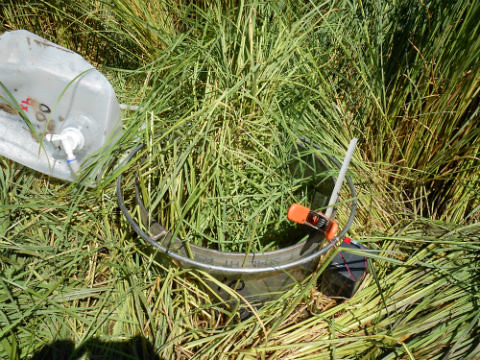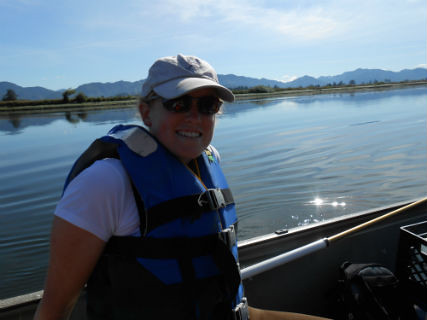The lab group and I have accomplished a great number of things this past week on the nutrient uptake research project here at the EPA. We traveled to the Salmon River and the Tillamook Bay estuaries where we carried out our experiments. At each study location we set up six chambers like the one shown below: two in the channel, two in the low marsh habitat, and two in the high marsh. The chamber is about two feet high so, as you might imagine, this chamber has been pushed into the ground. And that, my friend, has been the challenge of the week! We must use every bit of weight (human bodies and 2 sixty pound weights) plus muscle power to get these things in the ground. Each estuary and habitat is different so we never know what difficulty will await us. I’m always up for a physical challenge, though, being a runner!

To give you an idea of the experiment, we fill the chamber with artificial seawater made up in the lab (a rather tedious process) that contains various concentrations of nutrients. Then, over a one hour time period we take water samples every twenty minutes that will be analyzed later to determine how much nutrients have been taken up. We measure a bunch of other things like temperature, salinity, water depth, and plant biomass. All of this data will be looked at later and we hope by the end of the summer to tell a story about how nutrient uptake in Oregon coast estuaries works.
My fellow intern and I have also designed our own experiments to carry out and did our first experiment on Friday in the marsh here in Yaquina Bay, behind the Oregon Coast Aquarium. She is looking at how the ratio of nitrogen to phosphorous affects uptake and I am going to see if temperature of the water plays a role. This involves carrying 14L of water in a large cooler of ice to the study location…another physical challenge!
Overall, I like this sort of research. I am enjoying being outside and getting to see great stretches of the Oregon coast and its various estuaries. The people in my field group are also great fun to work with. Below is a picture of me on the Tillamook River, headed to the marsh.

Some aspects of the fieldwork get stressful as you have to remember to do every tiny task or it will make the data worthless. With so much effort put into packing for fieldwork, getting to the field site (driving, hovercraft, and boat) and setting up the experiment (pounding the chamber in), one small mistake would make all that work pointless. For instance, on Monday, just after some of us had gotten to lab at 6AM to prepare and we were about to pull away at 8AM, my mentor, who is the primary investigator and calls all the shots on this project, found out that the water hadn’t been stored in the cooler overnight. He initially told us to scrap the whole field day, and I almost cried! However, someone had the brilliant idea to let the cubitainers of water incubate in the river before the experiment, which worked to keep the temperature down and all our work that morning did not go to waste.
Next week we work on our experiments two of the days and then travel to other estuaries the other two days. The 4th of July, our day off, my roommates and I plan to explore the tide pools since there is supposed to be record low tides that day.






